Discover Extension
Delivering Solutions to Improve Lives For All New Mexicans
Discover how Extension delivers solutions to improve lives across our great state.
The New Mexico Cooperative Extension Service (CES), part of the New Mexico State University College of Agricultural, Consumer and Environmental Sciences, provides practical, research-based knowledge and programs to serve the citizens of New Mexico. This has been our mission for more than 100 years and will remain the crux of our efforts in the future.
We focus on collaboration to foster economic, educational, and community development, keeping the needs of our neighbors at the forefront of our work. While our mission endures, the delivery and areas of study evolve. Extension agents and specialists have worked during the last couple of years to create effective ways for youth to access science, technology, art and math education opportunities as well as identify and address behavioral health concerns for not only our children and families, but also in our agricultural communities.
CES has worked in numerous ways to assist our communities hit the hardest by devastating wildfires and continues to work with multiple state agencies to protect our food supply and develop programs to address a wide range of potential threats to our agricultural infrastructure. CES specialists continue to address the challenges of making critical management decisions through extended drought conditions and work to promote economic development through agriculture.
The programs highlighted here are a sample of the amazing work done across the state to improve the lives of New Mexicans, but it is critical that we remain responsive and advance our programs and research in areas we have identified as critical to our state’s future – STEM, agriculture and natural resource policy, water and energy will be important areas to pursue in the coming years.
Jon Boren, Ph.D.
Associate Dean/Director
NM Cooperative Extension Service

Youth Programs
NM STEAM Virtual Innovator Program Connects Communities and Science
Enrollment logs for the first set of the NM STEAM Virtual Innovator Program can tell you that, in its first year, the initiative’s workshops reached nearly 300 kids across the state.
The true impact of the NM STEAM Virtual Innovator Program, however, is in many ways immeasurable. The virtual learning series, launched by a team of New Mexico State University Cooperative Extension Service faculty, allowed participants to explore and make personal connections to STEAM (science, technology, engineering, art and math) education.
New Mexico youth have not only increased experiential learning and interest in STEAM education, but increased community and family bonds.
“Since projects are implemented at home, families are brought together to work on them, strengthening familial bonds and STEAM literacy in the community,” said Peter Skelton, Extension youth agriscience education specialist.
Aside from these benefits, the NM STEAM Virtual Innovator Program also helped the kids develop skills that will serve them in their lives, no matter which field they enter.
Added Skelton: “Youth have indicated participation in the innovator program has provided an environment for them to communicate information to a larger audience, lead a group of youth to complete a project, work effectively with people they do not know, better serve their club, and improve their knowledge base about a suite of STEAM activities.”
The NM STEAM Virtual Innovator Program began out of necessity, launching during the early stages of the pandemic, when in-person programs went dark.
To keep 4-H programs moving forward amidst COVID-19, a group of NMSU Extension faculty, consisting of Amanda Benton of Santa Fe County; Eva Madrid of Doña Ana County; Courtney Mitchell of Harding County; Brittany Sonntag of Bernalillo County; and Sierra Cain of Valencia County, formed the team and decided on the creation of a monthly virtual series. Activities are offered on a variety of STEAM topics such as computer science, physical science, engineering, art fusion and simple machines.
Six youth innovators have been leading the program for almost a year. Innovators must be part of 4-H, but the program is open to all youth ages five to 18 years old across the state.
“When we started the program, we had only a vague idea of what we thought we could accomplish,” Skelton said. “What we found was an amazing group of youth willing to take the lead and allow us to realize the potential of this program.”
As a result, the program has been extended.
To learn more about 4-H, visit the state 4-H newsletter at https://nm4h.nmsu.edu/ or visit the NMSU 4-H virtual events page at https://nm4h.nmsu.edu/4h/virtual.html.
ANS is setting up NM’s future workforce for success in college and beyond
Life after high school can be daunting to many students. Life after college can be just as overwhelming. In order to ease the transition during these two chapters in a student’s journey, Aggie Next Step has implemented different programs to help students in grades 8th through 12th navigate each transition.
ANS is reaching students where they are. Through a series of five 30-minute workshops called “Take it to the Next Level: Skills for Student Success,” ANS helps students focus on skills important for academic success including decision making, goal setting, time management and organizational skills, personal responsibility and positivity. Currently, ANS is in its second year at Cliff and Truth or Consequences middle schools, and it’s being piloted in Dulce and the School of Dreams Academy eighth grade classrooms. Ninth grade curriculum is being piloted in Hot Springs, Cliff, and Belen high schools.
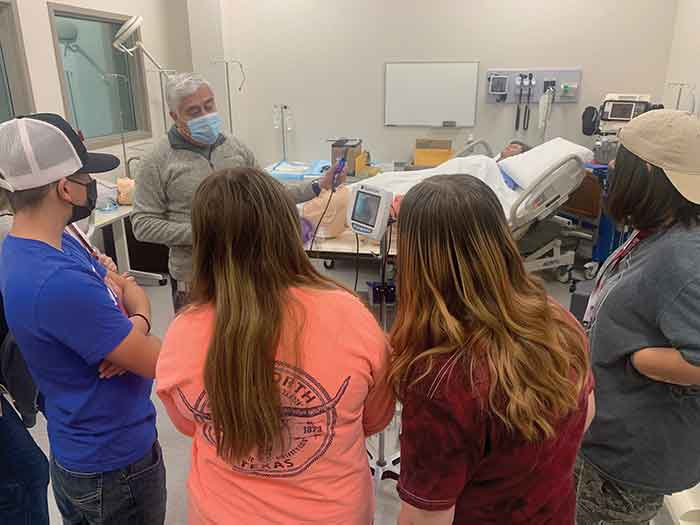
“As the school counselor, I felt this was a wonderful opportunity for the students to have exposure to different postsecondary learning options and to begin thinking about their own future plans,” said Tommye Allsup of Cliff Schools.
Cultivating a more skilled and educated workforce in NM is also top priority for ANS through its College Experience (ANS-CE). Encouraging youth to think about life after college, ANS-CE invites students to campus and introduces them to faculty members and current students, and shows them student life on campus. ANS-CE first piloted its program with a three-day campus visit in December 2021. Five NMSU colleges, 17 departments and 22 experiential learning activities were on hand to provide participants with a peek into college life, and information on what careers are available after graduation.
A post survey of eighth grade students revealed that 57% of those who participated in the survey answered “very likely” to attend NMSU compared to 5% in a pre-survey.
Mental Health
New Center Serves Hundreds with Behavioral Health Resources
Strengthening a comprehensive system of care throughout a vast and diverse state like New Mexico is no small task.
Thanks to Extension staff with a range of expertise, and partners across the state, that’s exactly what The Center of Innovation for Behavioral Health and Wellbeing, or COI, has been doing. So far, COI — housed in the Extension Family and Consumer Sciences Department in the College of Agricultural, Consumer and Environmental Sciences’ Cooperative Extension Service at NMSU — has helped hundreds of people through numerous programs and initiatives.
COI’s mission: provide foundational support for New Mexico children and families by advancing the reach and capacity of the behavioral health workforce. That manifests via several programs and initiatives, all aligning with the center’s core values. The organization believes that “children and families deserve the best possible chance to live out their hopes and dreams” and that its “responsibility is to ... provide a safe and equitable pathway for them to do so.” At its core, COI values human dignity.
One example of the many COI programs is Family Peer Support. That program assists parents and primary caregivers who need guidance on how to navigate various support systems. Trained and certified Family Peer Support Workers, who themselves have personal experience “parenting a child, youth, or young adult with emotional, behavioral, and mental health challenges” work with the parents and/or primary caregivers.
“As a state, New Mexico is still working hard to recover from the 2013 behavioral health shake-up that resulted in the closure of many long-standing, community-based behavioral health agencies,” said COI Director Brooke Stanley Tou. “At COI, we’re…supporting community-based programs to thrive…A lot of that comes back to training, but it’s also coaching and mentoring programs, outreach and community awareness.”
New Mexico’s behavioral health care system is stretched thin. According to Mental Health America, a nonprofit, New Mexico ranks 42nd in behavioral health care for youth, indicating they have a higher prevalence of mental illness and lower rates of access to care.
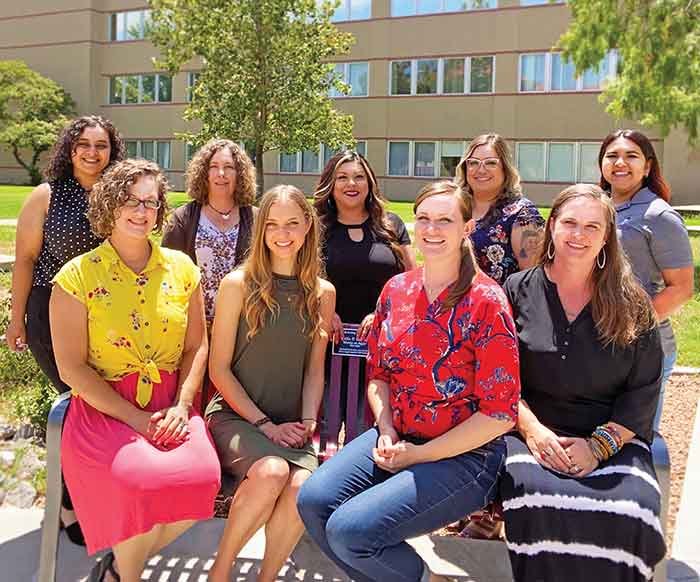
In the past decade, the state’s mental health care system faced external challenges that made it difficult for people to get services. About 55% of those in need of mental health care in New Mexico do not receive treatment, according to federal data.
Stanley Tou envisions COI serving as a “training hub and workforce development center” to bolster the state’s system, specifically for those under 21. That would include adding qualified providers — crucial in a system with waiting lists — and allowing existing providers to focus more on patients rather than organizing trainings and other support systems.
“One thing that we’ve learned is that you can’t just throw training at groups,” Stanley Tou said. “You need to support them over time. We support them from beginning to end.”
For more information about the NMSU Center of Innovation for Behavioral Health and Wellbeing, visit
https://aces-centerofinnovation.nmsu.edu/.
Quilting for better mental health

Today’s youth have a lot to process on a daily basis – general teenage angst, social media, and family issues, just to name a few. Add in a global pandemic and that can be overwhelming to say the least.
Researchers have found that our newest generation has a shorter attention span as well as difficulty committing to projects that take time to complete. In addition, it was also discovered that young people have been having a tough time managing their feelings for the last several years.
In hopes of addressing these issues, a series of quilt workshops were developed by Lincoln County Extension Agents during spring and summer of 2022. Children 7 to 14 years old participated in the camps with surprising and promising results.
The program’s impact resulted in 80% of participants reporting that they learned to better manage their feelings during the workshops; 74% said they now understand that taking time for a project and doing it right is very fulfilling; and 66% expressed they are more self-motivated with many other aspects of their life.
Agents used New Mexico 4-H curriculum to teach participants how to make three different quilts and matching pillowcases. Most of the projects took two full days to complete.
“The program will continue as long as there is interest. There are four quilt patterns that we go through; we start with the easiest and work our way up,” said Melanie Gutierrez, Lincoln County Program Director and Agricultural Extension and 4-H Agent. “Not all quilts are done in a calendar year so to get through all four quilts is a 2-4 year commitment.”
A trusted resource for mental wellness
The state of mental health across the U.S. is alarming, and in the Land of Enchantment, its no different.
The growing and pressing need for trained professionals who can identify, understand and respond to mental health challenges in New Mexico led to the formation of a multidisciplinary team of Extension professionals in 2019. The team found that by providing professional development opportunities, Cooperative Extension Service faculty and staff can be well-positioned to help address these issues.
Through evidenced-based programs such as Youth Mental Health First Aid (YMHFA) and Question, Persuade and Refer (QPR), CES professionals are trained to spot signs, symptoms and risk factors of mental illnesses and addictions; identify multiple types of professional and self-help resources; increase their confidence and likelihood to help individuals in distress; and learn how to recognize warnings of a suicide crisis and how to question, persuade and refer.
By early 2021, six faculty were trained as YMHFA instructors and 23 CES faculty, staff and community partners were trained as QPR instructors.
Comments after trainings include: “I really enjoyed the course and I am excited to charge into my new job better equipped to be of service,” said one YMHFA participant. While a participant of the QPR program noted, “It is a good overview of the issue with practical steps to address it.”
Helping families thrive
Funded by the New Mexico State Legislature in 2019, the Anna, Age Eight Institute ensures that children, students and families are trauma-free and empowered to succeed in family life, school and the workplace.
The program believes that aligned with local leadership, each county can work together to solve the problem of dealing with childhood trauma and maltreatment. The work of the initiative builds on current local efforts to improve systems of care.
The Anna Age Eight program uses what they call the “100% New Mexico Initiative.” With this model, the Institute surveys county residents and reviews survey results to identify service gaps; assesses the 10 services that are successful; provides an updated directory; identifies innovative solutions to end barriers; gets buy-in from local government; and evaluates effectiveness of innovations. While most survey respondents reported focusing on updating the county directory and identifying innovative policies, all of the counties had different areas they felt they needed improvement on in order to reach the 100% initiative.
“In light of [the recent] pandemic, these efforts to identify and create … accessibility to these vital services is more necessary than ever. I call on all our county’s stakeholders to get involved so we can ensure every child and family gets the support they need,” said Michelle Perry, Associate Vice President of NMSU Alamogordo’s Extended Programs.
NMSU Extension, NMDA, NM Farm and Livestock Bureau Partner on Here to Help NM project
The agricultural industry is a constantly changing field due to stressors such as variable weather patterns and changing market prices. And as a result, mental health challenges and suicide rates have increased in agricultural communities. To provide assistance to agricultural producers and their families, New Mexico State University’s Cooperative Extension Service, the New Mexico Department of Agriculture and New Mexico Farm and Livestock Bureau have joined forces to support Here to Help New Mexico.
Through the Southwest Border Food Protection and Emergency Preparedness Center, Here to Help New Mexico enhances existing efforts to increase stress prevention, wellness and health resources.

In this collaboration, Extension uses its community outreach expertise to deliver educational programs in communities throughout the state. Southwest Border Food Protection and Emergency Preparedness Center
Co-Director Tom Dean acknowledges the challenges to having conversations on topics such as behavioral health.
“Most people don’t want to talk about it in a public program,” Dean said. “Our primary emphasis is dealing with stressors and stress management. If we can do that, we can help promote those conversations after community meetings and help people identify when someone might be in trouble with issues.”
Here to Help New Mexico works to improve behavioral health, reducing and mitigating stress, and providing positive outcomes for the state’s agricultural communities.
“As they face endless difficult challenges – including drought, wildfires and high input costs – our farmers and ranchers need our support now more than ever, especially related to stress and mental health,” said New Mexico Agriculture Secretary Jeff Witte. “The pressure of feeding the world is real. While our New Mexico farmers and ranchers are resilient, they are not immune to stress, so it is important that these resources are available.”
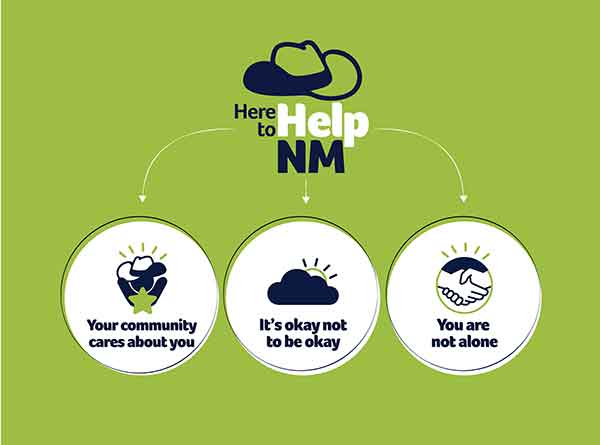
In addition to helping agricultural producers and their families, Here to Help New Mexico also has been aiding families who have been impacted by the recent wildfires in the state.
Not only will Extension share Here to Help New Mexico educational programming in all 33 counties in the state, Extension faculty have been trained to recognize signs of mental health issues, especially when working with youth who are involved in agricultural programs.
The Here to Help New Mexico website features information about mental health challenges, steps to help someone in emotional pain, crisis hotline numbers, a survey to access stress and health and “Stress Free You” videos from Matt Rush, who has done considerable research on the topic.
The project was established with funding through the New Mexico Farm and Ranch Stress Assistance Network from a $500,000 United States Department of Agriculture’s National Institute of Food and Agriculture grant.
On the national level, the new 988 Suicide and Crisis Lifeline, launched July 16, is a service that provides 24/7 support for mental health crisis.
To learn more, visit Here to Help New Mexico, https://www.nmflb.org/Get-Involved/Here-To-Help-NM.
Diversity, equity and inclusion
Extension-Run Program Promotes Understanding
We have to learn from the past to create future possibilities.
That’s a quote Karim Martinez jotted down at a recent training session with Carolyne Abdullah of Everyday Democracy, and it encapsulates the impact that Martinez and Laura Bittner are creating through a national program they have brought to NMSU and Cooperative Extension: Coming Together for Racial Understanding.
Martinez, an Extension specialist, and Bittner, the interim department head of 4-H Youth Development also serve as co-directors of the Equity, Inclusion and Diversity initiative within the College of Agricultural, Consumer and Environmental Sciences. After recently being appointed to lead the EID initiative for ACES, the duo looked for relevant programs and found Coming Together for Racial Understanding.
The end goal, Martinez says, is learning what a community is willing to do to address equity issues with specific action steps.
“At the beginning, you’re practicing listening to people’s experiences,” Martinez says. “You’re building trust. And then you’re having conversations about why inequalities exist. Everybody has different views about that. And then the end session is where the group comes together to talk about action items. … The group itself decides how they’re going to address those inequalities.”
Bitner says, so far, that she, Martinez, and their small team of initial CTRU trainers have focused their efforts internally and have reached 230 faculty, staff and administration within the College of ACES. Most of the 33 other state Extension offices participating in CRTU programming are developing it this way, Bittner says.
“We want everybody to feel prepared,” she says.
NMSU is helping to grow this program. According to the most recent CTRU data, 964 Extension staff nationally in 24 communities have taken some training. Initially, organizers say they are seeing: increased empathy and deeper listening; deeper relationships with colleagues and partners; increased awareness of institutional bias and privilege, and a normalizing of conversations on race.
That impact should increase once Martinez, Bittner and the growing number of trainers are able to provide the full six-week CTRU course.
Both Martinez and Bittner, in previous Extension experiences, wanted to find ways to reach people statewide who weren’t participating in Extension programs, whether it be due to lack of awareness, language barriers or whatever else the obstacles may be.
Strengthening community bonds, providing college pathways

The mission of the New Mexico Tribal Extension Program is to develop and deliver community-based education programs that revitalize agriculture, implement culturally appropriate youth leadership programs and strengthen the bonds between individuals, families and communities. Programming is based on the needs of each community; local residents make up advisory boards that provide input and support for programming.
Bringing together traditional teachings and Extension programming, Tribal Extension works to connect with native communities. Programming includes education on food and nutrition, food preservation, weaving, gardening, Lego robotics, solar cars, and much more. Also a priority, increasing the number of college bound Native Americans who complete their degrees in New Mexico.
From 2008-2019, more than 500 youth participated in gardening projects, 165 adults participated in the Kitchen Creation program, and 118 individuals attended food preservation workshops and began canning their own vegetables.
With the goal of making a connections, tribal cultures and language are incorporated into presentations for both youth and adults. For example, a class on cake decorating introduces youth to the Navajo words for various cooking utensils. The Kitchen Creations program teaches techniques to prepare and serve traditional foods in a healthy way, thereby helping to address the problem of diabetes, a prevalent health condition. Young people enjoy hearing about tribal traditions during 4-H project meetings and, similarly, the program on horses instructs participants on how the animals tie into the Navajo culture.
Wildfire Recovery
Extension Serves NM Through Historic Wildfire Season
In response to New Mexico’s devastating and historic fire season through the spring and summer, the Cooperative Extension Service is working in numerous ways to help residents recover, prepare and mitigate damage from future blazes.
Not only did it begin earlier than usual, according to officials, but this year’s fire season also included the largest wildfire in New Mexico history — the Calf Canyon Hermits Peak Fire near Santa Fe, which burned more than 530 square miles, and took four months and $300 million to contain.

Throughout that fire and all the others, Extension has been connecting with multiple local, state and federal agencies, and directly helping community members. Here are some of the ways Extension helped:
Extension personnel participated in daily Emergency Support Function calls to ensure efficient use of resources and no duplication of efforts by the agencies, giving everyone involved some knowledge about the critical needs and which group will handle them.
In counties with active fires, Extension agents provided evacuation education.
Agents in counties hit hardest by the Calf Canyon Hermits Peak Fire, collected items for evacuees.
Extension provided leadership and deployment of pet shelter trailers that provided needed pet supplies at evacuation sites.
Coordinating with hay producers, Extension agents acquired livestock feed (through donations) and delivered the feed to designated sites.
Going forward, Extension will continue to support the people of New Mexico by implementing post wildfire programs to address issues involving livestock producers, soil and watershed management, water quality, mental health or social economics.
Learning to live with fire
More New Mexicans are now better equipped with knowledge and strategies on wildfire preparedness due to a four-part weekly webinar series developed by NMSU CES Extension agents, specialists and the New Mexico State Forestry.

“Learning to Live with Fire” was held in March of 2022 and focused on practical tools for immediate evacuation; proactive steps for individual and family preparedness; safeguarding home, yard and neighborhood against fire; strategies for evacuating livestock and how to properly identify insect and disease tree mortality.
One-hundred and thirty-four New Mexicans from across the state registered for the series with 20% of participants responding to an electronic survey after each session. Of those who responded to the survey, 100% said they would recommend the workshop to others. A follow up survey indicated that 89% of respondents had made preparations for immediate evacuation and 94% have safeguarded their property from wildfire since participating in the webinars.

Participants included homeowners, volunteer fire fighters, home association members and employees from NMSU, UNM, county, state and federal government agencies.
For more information, visit nmrxfire.nmsu.edu/index.html.
Prescribed Burning: A proactive approach to harnessing a natural process
This year, New Mexico’s blue skies turned dark with smoke from record-setting wildfires. Left behind was pure devastation – hundreds of acres burned, homes destroyed, livelihoods lost, among other challenges. As much as it is devasting, wildfires in the arid Southwest are inevitable.
Continued training and the creation of a burning culture in New Mexico may ease the grip wildfire has on society, said Extension Specialist Douglas Cram.
Through the Prescribed Fire Training Curriculum – as outlined in the New Mexico Prescribed Burning Act – Extension agents are working to expand the burning footprint in the state. Since 2014, 245 practitioners have been trained through six training burns on 725 acres of private land.
“Prescribed burning changes wildfire behavior and returns an ecological process to the landscape,” Cram said. “By reintroducing fire back to the landscape, land managers can reduce the negative effects of wildfire by reducing hazardous fuel loads as well as achieve a range of land management goals such as brush management, improved forage utilization, and enhanced wildlife habitat.”
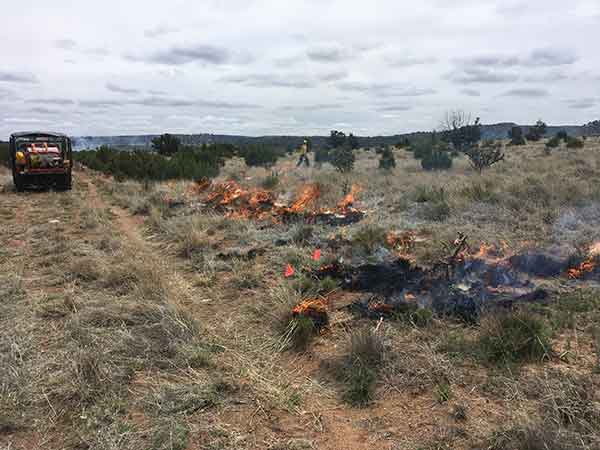

Range Monitoring
Extension Teaches New Mexico how to Navigate Persistent Drought

Pasture yield is limited, and producers are selling livestock. Irrigated crops: stunted. Dryland crops: brown. Wildfires may increase.
These are some of the ways the National Integrated Drought Information System describes about 60% of New Mexico, placing most of the state within its “severe drought” category.
With limited relief on the horizon, NMSU’s Extension Animal Science and Natural Resource Specialists conducted a webinar series discussing production strategies to help New Mexico producers navigate extended drought conditions.
Through the webinars, along with an in-depth set of downloadable assets, Extension provided research-based information on several range monitoring-relevant topics, including calf management, wildfire preparedness and how to interpret range-monitoring data.
NMSU Extension Beef Specialist Craig Gifford discussed the impacts of weaning calves earlier than normal — doing this correctly can be an effective tool to mitigate the impacts of drought. Separately, he also talked about calf vaccination protocols.
Marcy Ward, an Extension livestock specialist, developed a presentation detailing how to select cows and bulls for maximal feeding efficiency, which also can be vital during drought. More specific to bulls, John Wenzel, NMSU’s Extension veterinarian, talked about managing them throughout the year.
Extension specialists also created plenty of materials on range monitoring. Casey Spackman, an NMSU Extension range specialist, delivered a basic synopsis of monitoring and why it’s even more important under drought conditions. Later, Spackman gave information on how to compile and interpret rangeland monitoring data.
Doug Cram, NMSU Extension forestry and fire specialist, went over home and range wildfire preparedness tactics, giving simple tips that everyone in the family can do to keep safe.
Those webinars and materials are available at: nmdeptag.nmsu.edu/drought-resources.html.
Planting new seeds of knowledge
A collaborative project is underway to help close the information gap on forage adaptation and proper management techniques on New Mexico’s tribal lands. With more than one million livestock animals in New Mexico, there’s a need to evaluate non-native, high-quality pasture and feed in order to provide well-informed pasture recommendations to the state’s diverse clientele and stakeholders, especially in northern New Mexico where one-third of the area is well suited for cool-season perennial grasses and legumes.
In 2021, funding for this project was received through the NRCS to establish and monitor pasture demonstrations on multiple tribal entities. Working together — local tribal officials, tribal members, NMSU Tribal Extension and NMSU Agricultural Science Centers — plantings have begun and initial data is being collected. Up to 15 different species are being utilized. These pasture-grazing models help landowners better predict production of potential grasses and animal performance.
NMSU’s Cooperative Extension Service continually receives requests from producers in northern New Mexico seeking forage-related information; however, only limited or anecdotal information was available prior to this project to properly counsel consumers.
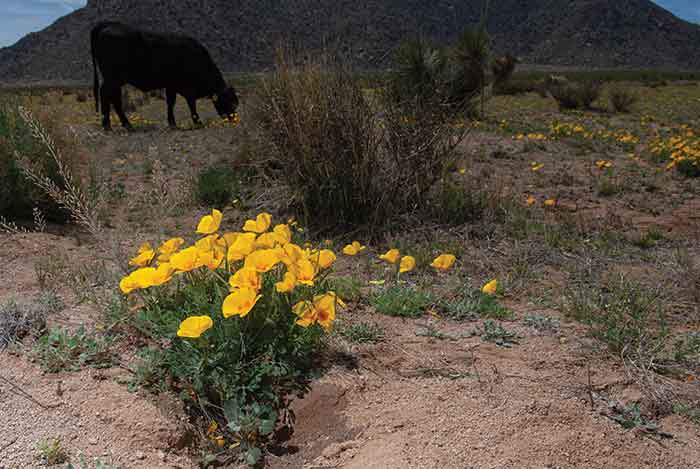
Food Security
Extension Helps Keep Ag Workers Prepared
Agriculture is known as the engine that drives the economy in most of New Mexico’s 33 counties.
For almost 20 years, the Southwest Border Food Protection and Emergency Preparedness Center (SWBFPEPC) has been helping to ensure that engine is protected and running safely, all while making its mark across the state, nation and even the world.
The impact of SWBFPEPC — a collaboration between NMSU and the New Mexico Department of Agriculture — can be felt in various ways.
The most common may be through the SWBFPEPC’s multiple trainings, which are designed to protect America’s food supply from threats such as foodborne illness, supply chain disruption and agroterrorism. The program trains emergency responders, law enforcement, Extension personnel and New Mexico Department of Agriculture personnel in agriculture security, food protection and family, business and community preparedness.
Through its work with Cooperative Extension, SWBFPEPC helps counties develop agriculture preparedness plans.
Also, SWBFPEPC assesses the security of agriculture operations through our AGROGUARD program and provides training for farmers, dairy and livestock producers, and more.
The program partners with institutions around the state and nation.
The New Mexico Department of Homeland Security and Emergency Management has designated the SWPFPEPC as the training point of contact for all approved training opportunities dealing with agriculture. That means SWBFPEPC hosts exercises with partners from across New Mexico in addition to the 10 states along the Mexican border. Some staff, with our partnering universities, have helped develop Department of Homeland Security-certified training courses that are taught nationwide and internationally.
Another program, the Syndromic Surveillance Project, is quickly becoming the model for animal disease surveillance across the United States. In New Mexico, this is called the ALIRT Program (Agriculture Livestock Incident Response Team).
SWBFPEPC also maintains first-response trailers across the state stocked with equipment to help officials respond to an agriculture emergency.
Program provides local access to fruits and vegetables


Thanks to a grant-funded program by the NM Legislature, farmers and producers are tapping into unexpected markets, and school children are getting access to local fresh fruit and veggies.
The NM Farm to School and Farm to Institution program allows schools and institutionalized residences to get reimbursed for purchasing fresh fruits and vegetables grown in New Mexico. However, in order to purchase the produce, schools and institutions asked for farmers to undergo food safety trainings, risk assessments, or third-party safety certifications.

Administered by the NM Farmers Marketing Association, NMSU’s Cooperative Extension Service and other community partners provided trainings, carried out on-site visits and helped with safety plans. Since 2019, numerous farmers and producers have been able to sell their crops to schools and institutions totaling more than $1 million in sales. In addition, more than $1 million in reimbursements to schools and institutions have been completed.
The success of the program has been recognized by Whole Foods, various CO-OP Markets, and grocery stores who are now purchasing NM grown produce from farmers who have food safety trainings and plans in place.
Community and economic development
AgriBusiness Accelerator Program Opens Doors to Opportunity in Northern New Mexico
New Mexico State University’s Cooperative Extension Service is known for fostering connections that improve people’s lives.
One of the latest connections helping New Mexicans is located up north, as Extension has partnered with NMSU’s main economic development arm, which is known as the Arrowhead Center, the State of New Mexico and local community leaders.
The Northeast New Mexico AgriBusiness Accelerator’s impact has broad potential. The program has leveraged its connections to achieve three main goals: increase the supply and accessibility of locally produced food; boost value-added AgriBusiness activity, and foster entrepreneurship, business development and job creation.
It features two components, the AgriBusiness Accelerator and the Farm Incubator.


The accelerator is a five-week business boot camp which assists New Mexico-based companies to test the feasibility of their agri-food idea by giving them access to experts, advising, network connections and new opportunities to earn investors and grant money. Before this opened in northern New Mexico, the only physical location for such programs was Las Cruces.
Tailored to the Las Vegas area, the Farm Incubator has established a training farm at a former middle school campus. The city provided two acres with water rights where those interested in farming can learn how to plan, produce and sell fresh fruits and vegetables for local and regional markets, said Michael Patrick, NMSU Extension community resource and economic development specialist.
The training farm tackles challenges and finds opportunities for improving farm and ranch productivity, and strengthening local supply chains. It’s also where staff will conduct workshops, field demonstrations and mentoring.


Patrick has called it a model that can be replicated across the state.
The first phase of this pilot program was funded by the New Mexico Legislature via appropriation. It was envisioned and supported by longtime State Senator Pete Campos, D-District 8.
“They are definitely buying into the fact that this is going to be the future of their region,” Campos said. “We are seeing people within the communities and region becoming more invested with their time and expertise.”
NM EDGE: Better government through education
Every year, administrators, elected officials, and staff members in all levels of government learn the best management practices and theories through the College of ACES Cooperative Extension Service.
Public servants receive certification in their fields through NM EDGE, a nationally-accredited program which stands for Education Designed to Generate Excellence in the public sector. During fiscal year 2022, NM EDGE served 1,621 individual officials and government employees.
“NM EDGE County College is a great opportunity for county elected officials and employees to advance their skills and knowledge in areas that pertain to county government while obtaining a valuable certification,” said Lance A. Pyle, CPO, Curry County Manager. “I strongly encourage all counites to support and participate in this excellent certification program. The minimal cost is funds very well spent!”
To obtain a certification designation, students must complete a required number of three-hour classes depending on the certification, and a portfolio demonstrating, through written and project work, their application of the competencies learned by participating in the classes.
Through this curriculum, participants can receive the following certifications: NM Certified Public Official, NM Certified Public Manager, NM Certified Advocate for Public Ethics, NM Certified GIS Specialist, NM Certified IT Professional, NM Certified Public Purchasing Professional, and more.

Future priorities
Extension Evolves to Meet Emerging Challenges
As the New Mexico Cooperative Extension Service (CES) considers the most emergent challenges faced by our state, additional specialist positions will be critical to developing programs and providing resources to our communities.
Extension faculty who specialize in an area of concern to New Mexicans bring a wealth of knowledge and resources to communities and often represent the single state-wide or regional source for research-based information on a particular topic.
An Agricultural and Natural Resources Policy Extension Specialist will provide programming to aid stakeholders in interpretation of federal, state and county statutes, regulation and policy regarding water, land management, the environment, beef cattle, sheep and dairy production, and estate planning that influence agricultural production and natural resource management in New Mexico.
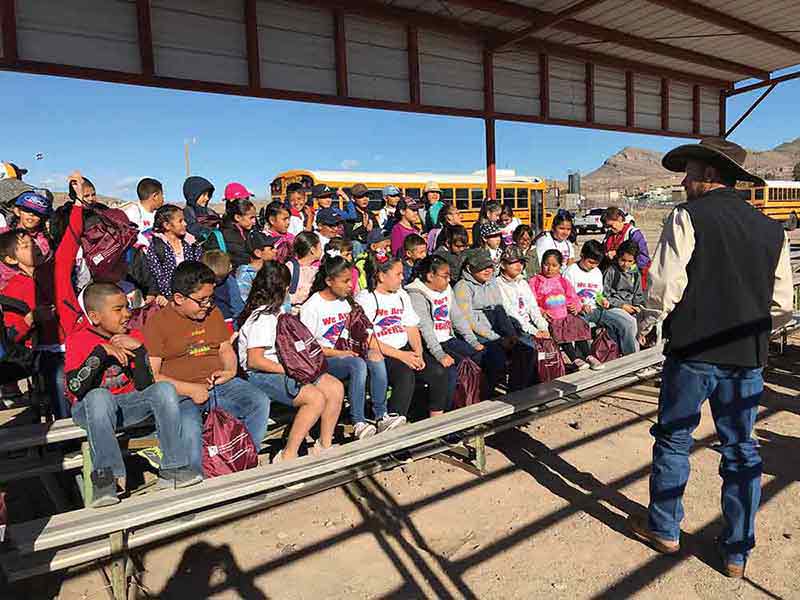
A stimulating STEM education is essential for developing the basic analytical, problem-solving, and critical thinking skills central to academic achievement and workforce readiness in the 21st century. Schools cannot tackle this issue by themselves. Children spend less than 20% of their waking hours in school. Afterschool programs offer both additional time and the opportunity to diversify the ways that students experience STEM learning. The 4-H program has a rich history of providing developmentally appropriate, experiential learning opportunities in and outside of school hours introducing youth to STEM related projects and careers. With the addition of a 4-H STEM Extension Specialist, the New Mexico 4-H program will address these concerns by fostering quality science learning, promoting science literacy of youth and adults, and generating interest in and awareness of science-related education and careers.
An Energy Extension Specialist will provide programming in renewable energy and energy efficiency in an unbiased manner. It will cover residential, agricultural, and commercial energy areas of interest. Programs will include renewable technologies and their applications, home energy efficiencies and energy assessments.
New Mexico has for centuries dealt with numerous challenges relating to the supply, quality, and management of our precious water resources. A growing population, shifts in agricultural production, ongoing drought, intensifying wildfires, climate change, and dynamic relationships with neighboring states and Mexico create a unique set of ongoing issues that affect local communities, economies, and ecosystems throughout the state. A Water Conservation Extension Specialist will provide leadership in science-based extension education programming for agricultural producers and other water users, including management practices to protect water resources, efficient irrigation technologies, and water use in urban and suburban landscapes.
These Extension Specialists will be vital to the future of New Mexico.
Serving the state
The College of ACES Cooperative Extension Service exists to serve all New Mexicans, wherever they live. We reach every corner of New Mexico thanks to 54 offices— at least one in each of New Mexico’s 33 counties. We provide a wide range of research-based information and deliver that knowledge in whatever way it is needed. We have more than 250 faculty and staff, along with 10,000 volunteers, all dedicated to improving the quality of life for their fellow New Mexicans through discovery.
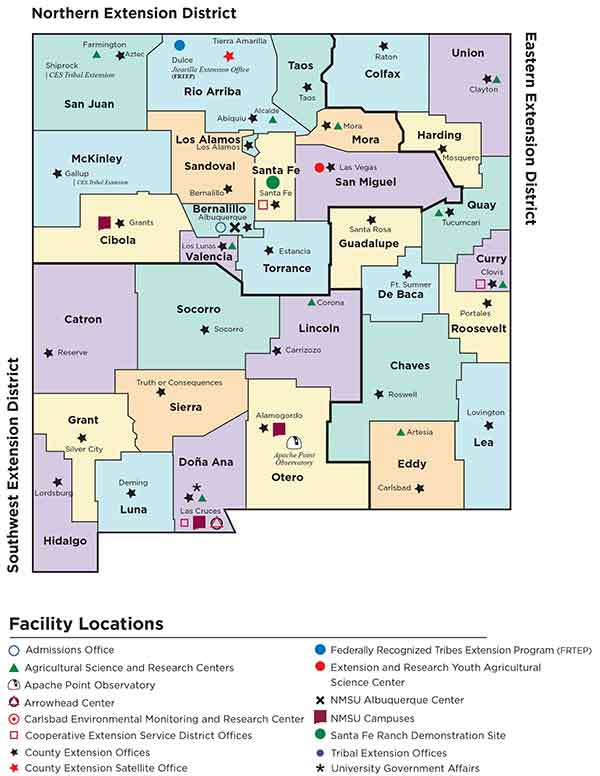
County Extension Offices
Bernalillo County
505-243-1386
bernalillo@nmsu.edu
bernalilloextension.nmsu.edu
Catron County
575-533-6430
catron@nmsu.edu
catronextension.nmsu.edu
Chaves County
575-622-3210 / 3211
chaves@nmsu.edu
chaves-extension.nmsu.edu
Cibola County
505-287-9266
cibola@nmsu.edu
cibolaextension.nmsu.edu
Colfax County
575-445-8071
colfax@nmsu.edu
colfaxextension.nmsu.edu
Curry County
575-763-6505
curry@nmsu.edu
curryextension.nmsu.edu
De Baca County
575-355-2381
debaca@nmsu.edu
debacaextension.nmsu.edu
Doña Ana County
575-525-6649
donaana@nmsu.edu
donaanaextension.nmsu.edu
Eddy County
575-887-6595
eddy@nmsu.edu
eddyextension.nmsu.edu
Grant County
575-388-1559
grant@nmsu.edu
grantextension.nmsu.edu
Guadalupe County
575-472-3652
guadalupe@nmsu.edu
guadalupeextension.nmsu.edu
Harding County
575-673-2341
harding@nmsu.edu
hardingextension.nmsu.edu
Hidalgo County
575-542-9291
hidalgo@nmsu.edu
hidalgoextension.nmsu.edu
Lea County
575-396-2819
lea@nmsu.edu
leaextension.nmsu.edu
Lincoln County
575-648-2311
lincoln@nmsu.edu
lincolnextension.nmsu.edu
Los Alamos County
505-662-2656
losalamos@nmsu.edu
losalamosextension.nmsu.edu
Luna County
575-546-8806
luna@nmsu.edu
lunaextension.nmsu.edu
McKinley County
505-863-3432
mckinley@nmsu.edu
mckinleyextension.nmsu.edu
Mora County
575-387-2856
mora@nmsu.edu
moraextension.nmsu.edu
Otero County
575-437-0231
otero@nmsu.edu
oteroextension.nmsu.edu
Quay County
575-461-0562
quay@nmsu.edu
quayextension.nmsu.edu
Rio Arriba County
(Main Office)
Abiquiu: 505-685-4523
rioarriba@nmsu.edu
rioarribaextension.nmsu.edu
Rio Arriba County
(Sub Office)
Tierra Amarilla: 575-588-7423
losojos@nmsu.edu
rioarribaextension.nmsu.edu
Roosevelt County
575-356-4417
roosevelt@nmsu.edu
rooseveltextension.nmsu.edu
San Juan County
505-334-9496
sanjuan@nmsu.edu
sanjuanextension.nmsu.edu
San Miguel County
505-454-1497
sanmiguel@nmsu.edu
sanmiguelextension.nmsu.edu
Sandoval County
505-867-2582
sandoval@nmsu.edu
sandovalextension.nmsu.edu
Santa Fe County
505-471-4711
santafe@nmsu.edu
santafeextension.nmsu.edu
Sierra County
575-894-2375
sierra@nmsu.edu
sierraextension.nmsu.edu
Socorro County
575-835-0610
socorro@nmsu.edu
socorroextension.nmsu.edu
Taos County
575-758-3982
taos@nmsu.edu
taos-extension.nmsu.edu
Torrance County
505-544-4333
torrance@nmsu.edu
torranceextension.nmsu.edu
Union County
575-374-9361
union@nmsu.edu
unionextension.nmsu.edu
Valencia County
505-565-3002
valencia@nmsu.edu
valenciaextension.nmsu.edu
Tribal Extension
505-863-3432
tribalextension.nmsu.edu



